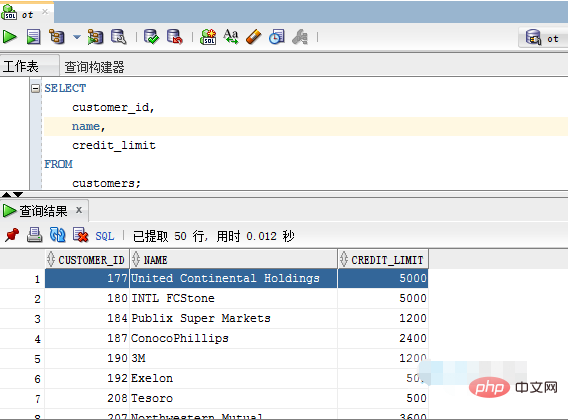How to query column data of a table in oracle
Method: 1. Use the "SELECT column name FROM table name;" statement to query the data of a single column; 2. Use the "SELECT column name 1, column name 2... FROM table name;" statement to query Query the data of multiple columns; 3. Use the "SELECT * FROM table name;" statement to query the data of all columns.

The operating environment of this tutorial: Windows 7 system, Oracle 11g version, Dell G3 computer.
In Oracle, a table is composed of columns and rows. For example, the customers table in the sample database has the following columns: customer_id, name, address, website, and credit_limit. customersThere is also corresponding data in these columns in the table.

To select one or more columns from the table (column_1,column_2,... ,column_n) to retrieve data, please use the SELECT statement with the following syntax:
SELECT column_1, column_2, ... FROM table_name;
In this SELECT statement:
- First, you need to specify the name of the table to query data.
- Secondly, specify the column in which you want to return data. If you need to return multiple columns, you need to separate these columns with commas (
,).
Please note that the SELECT statement is very complex and consists of many clauses, such as ORDER BY, GROUP BY, HAVING, JOIN. For the sake of simplicity, in this tutorial, we only focus on the usage of
SELECTandFROMclauses.
Oracle SELECT Examples
Let us give some examples using Oracle SELECT statements to understand how it works.
1. Query the data of a single column
To query the data from the customers (customers) table To obtain the customer name (name) column, please use the following statement:
SELECT name FROM customers;
Execute the above statement and return partial results as follows -
NAME ------------------------------------------------------------------------ Aetna AIG Intel Pfizer FedEx New York Life Insurance Ingram Micro American Airlines Group Johnson Controls Goldman Sachs Group Oracle 已选择319行。
2 . Query data from multiple columns
To query data from multiple columns, specify a comma-separated list of column names.
The following example shows how to query data from the customer_id, name and credit_limit columns of the Customers (customers) table .
SELECT
customer_id,
name,
credit_limit
FROM
customers;Execute the above example code and get the result

##3. Query the data of all columns in the table
The following example will retrieve data from all columns of thecustomers table, listing the names of all columns as follows:
SELECT
customer_id,
name,
address,
website,
credit_limit
FROM
customers;*) to instruct Oracle to return all columns from the table The data in the column is as follows:
SELECT
*
FROM
customers;*)carry out testing. In practice, even if you want to retrieve data from all columns of a table, you should explicitly specify the column from which you want to query the data.
*) in your application code, it is assumed that the table has a fixed set of columns, but the application may not handle other unrelated columns or access deleted columns.
Oracle Tutorial"
The above is the detailed content of How to query column data of a table in oracle. For more information, please follow other related articles on the PHP Chinese website!

Hot AI Tools

Undresser.AI Undress
AI-powered app for creating realistic nude photos

AI Clothes Remover
Online AI tool for removing clothes from photos.

Undress AI Tool
Undress images for free

Clothoff.io
AI clothes remover

Video Face Swap
Swap faces in any video effortlessly with our completely free AI face swap tool!

Hot Article

Hot Tools

Notepad++7.3.1
Easy-to-use and free code editor

SublimeText3 Chinese version
Chinese version, very easy to use

Zend Studio 13.0.1
Powerful PHP integrated development environment

Dreamweaver CS6
Visual web development tools

SublimeText3 Mac version
God-level code editing software (SublimeText3)

Hot Topics
 What to do if the oracle can't be opened
Apr 11, 2025 pm 10:06 PM
What to do if the oracle can't be opened
Apr 11, 2025 pm 10:06 PM
Solutions to Oracle cannot be opened include: 1. Start the database service; 2. Start the listener; 3. Check port conflicts; 4. Set environment variables correctly; 5. Make sure the firewall or antivirus software does not block the connection; 6. Check whether the server is closed; 7. Use RMAN to recover corrupt files; 8. Check whether the TNS service name is correct; 9. Check network connection; 10. Reinstall Oracle software.
 How to solve the problem of closing oracle cursor
Apr 11, 2025 pm 10:18 PM
How to solve the problem of closing oracle cursor
Apr 11, 2025 pm 10:18 PM
The method to solve the Oracle cursor closure problem includes: explicitly closing the cursor using the CLOSE statement. Declare the cursor in the FOR UPDATE clause so that it automatically closes after the scope is ended. Declare the cursor in the USING clause so that it automatically closes when the associated PL/SQL variable is closed. Use exception handling to ensure that the cursor is closed in any exception situation. Use the connection pool to automatically close the cursor. Disable automatic submission and delay cursor closing.
 How to create cursors in oracle loop
Apr 12, 2025 am 06:18 AM
How to create cursors in oracle loop
Apr 12, 2025 am 06:18 AM
In Oracle, the FOR LOOP loop can create cursors dynamically. The steps are: 1. Define the cursor type; 2. Create the loop; 3. Create the cursor dynamically; 4. Execute the cursor; 5. Close the cursor. Example: A cursor can be created cycle-by-circuit to display the names and salaries of the top 10 employees.
 How to paginate oracle database
Apr 11, 2025 pm 08:42 PM
How to paginate oracle database
Apr 11, 2025 pm 08:42 PM
Oracle database paging uses ROWNUM pseudo-columns or FETCH statements to implement: ROWNUM pseudo-columns are used to filter results by row numbers and are suitable for complex queries. The FETCH statement is used to get the specified number of first rows and is suitable for simple queries.
 How to stop oracle database
Apr 12, 2025 am 06:12 AM
How to stop oracle database
Apr 12, 2025 am 06:12 AM
To stop an Oracle database, perform the following steps: 1. Connect to the database; 2. Shutdown immediately; 3. Shutdown abort completely.
 What steps are required to configure CentOS in HDFS
Apr 14, 2025 pm 06:42 PM
What steps are required to configure CentOS in HDFS
Apr 14, 2025 pm 06:42 PM
Building a Hadoop Distributed File System (HDFS) on a CentOS system requires multiple steps. This article provides a brief configuration guide. 1. Prepare to install JDK in the early stage: Install JavaDevelopmentKit (JDK) on all nodes, and the version must be compatible with Hadoop. The installation package can be downloaded from the Oracle official website. Environment variable configuration: Edit /etc/profile file, set Java and Hadoop environment variables, so that the system can find the installation path of JDK and Hadoop. 2. Security configuration: SSH password-free login to generate SSH key: Use the ssh-keygen command on each node
 How to create oracle dynamic sql
Apr 12, 2025 am 06:06 AM
How to create oracle dynamic sql
Apr 12, 2025 am 06:06 AM
SQL statements can be created and executed based on runtime input by using Oracle's dynamic SQL. The steps include: preparing an empty string variable to store dynamically generated SQL statements. Use the EXECUTE IMMEDIATE or PREPARE statement to compile and execute dynamic SQL statements. Use bind variable to pass user input or other dynamic values to dynamic SQL. Use EXECUTE IMMEDIATE or EXECUTE to execute dynamic SQL statements.
 How to solve garbled code in oracle
Apr 11, 2025 pm 10:09 PM
How to solve garbled code in oracle
Apr 11, 2025 pm 10:09 PM
Oracle garbled problems can be solved by checking the database character set to ensure they match the data. Set the client character set to match the database. Convert data or modify column character sets to match database character sets. Use Unicode character sets and avoid multibyte character sets. Check that the language settings of the database and client are correct.








